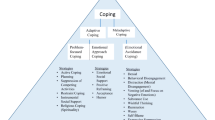Abstract
Differences in perceived self-concept and sexual response before and after spinal cord injury were examined. Twenty-four women between the ages of 20 and 40 completed a questionnaire and participated in a brief taped interview. Most of the women viewed themselves as very or somewhat attractive and had been involved in a sexual relationship since injury. The majority viewed sexual relationships as very enjoyable, although many commented that changes in bowel and bladder function had inhibited sexual expression. The need for more effective sexual counseling was highlighted. A trend was noted for an interrelationship between sexuality and self-concept in adapting to acquired disability.
Similar content being viewed by others
References
Berger, S. (1952). The role of sexual impotence in the concept of self of male paraplegics.Diss. Abst. Int., p. 12.
Bors, E., and Comarr, A. E. (1960). Neurological disturbances of sexual function with special reference to 529 patients with spinal cord injury.Urol. Surv. 10: 191–222.
Bregman, S. (1973). Behaviors relating to feminine attractiveness and sexual adjustment among women with spinal cord injuries. Unpublished Master's thesis, California State University, Los Angeles.
Cole, T. M. (1975). Sexuality and physical disabilities.Arch. Sex. Behav. 4: 389–403.
Comarr, A. E. (1965). Observations on menstruation and pregnancy among female spinal cord injury patients.Paraplegia 3: 263–271.
Conomy, J. P. (1973). Disorders of body image after spinal cord injury.Neurology 23: 842–850.
Crigler, L. (1974). Sexual concerns of the spinal-cord injured.Nurs. Clin. N. Am. 9: 703–716.
Friedland, F. (1968). Rehabilitation in spinal cord injuries. In Licht, S. (ed.),Rehabilitation and Medicine Waverly Press, Baltimore.
Goller, H., and Paeslack, V. (1972). Pregnancy damage and complications in the children of paraplegic women.Paraplegia 10: 213–217.
Griffith, E. R., Tomko, M. A., and Timms, R. J. (1973). Sexual function in spinal-injured patients: A review.Arch. Phys. Med. Rehab. 54: 539–543.
Guttman, Sir L. (1973).Spinal Cord Injuries: Comprehensive Management and Research Blackwell Scientific, Oxford.
Heslinga, K., Schellen, A. M., and Verkuyl, A. (1974).Not Made of Stone: The Sexual Problems of Handicapped People Thomas, Springfield, Ill.
Hetrick, W. R. (1967). Sexuality following functional transection of the spinal cord. Unpublished dissertation, University of Houston.
Hohmann, G. W. (1972). Considerations in the management of psychosexual readjustment in the cord injured male.Rehab. Psychol. 19: 50–58.
Knight, S. (1973). Sexuality and disability: A progress report. Unpublished manuscript, University of California at San Francisco.
Lindner, H. (1953). Perceptual sensitization to sexual phenomena in the chronic physically disabled.J. Clin. Psychol. 9: 67–68.
Masham, B. (1973). The psychological and practical aspects of sex and marriage for the paraplegic.Proc. Roy. Soc. Med. 66: 3–6.
Mayclin, D. (1974). A comparison of two educational programs in human sexuality with the physically disabled. Unpublished dissertation, University of Missouri.
Money, J. (1960). Phantom orgasm in the dreams of paraplegic men and women.Arch. Gen. Psychiat. 3: 373–382.
Robertson, D. N. S. (1972). Pregnancy and labour in the paraplegic.Paraplegia 10: 209–212.
Romano, M. D. (1975).Sexuality and the Disabled Female Accent on Living Inc., Bloomington, Ill.
Rusk, H. A. (1971).Rehabilitation Medicine Mosby, St. Louis.
Tarabulcy, E. (1972). Sexual function in the normal and paraplegia.Paraplegia 10: 201–208.
Tsuji, I., Nakajima, S., Morimoto, J., and Nounata, Y. (1961). The sexual function in patients with spinal cord injury.Urol. Int. 12: 270–280.
Wachs, H., and Zaks, M. (1960). Studies in body image in men with spinal cord injury.J. Nerv. Ment. Dis. 131: 121–127.
Weiss, A. J., and Diamond, M. D. (1966). Sexual adjustment, identification, and attitudes of patients with myelopathy.Arch. Phys. Med. Rehab. 47: 245–250.
Wright, B. (1960).Physical Disability; A Psychological Approach Harper, New York.
Author information
Authors and Affiliations
Additional information
The present study is based on a research paper submitted by the first two authors in partial fulfillment for the Master of Arts in Physical Therapy at Stanford University School of Medicine.
Rights and permissions
About this article
Cite this article
Fitting, M.D., Salisbury, S., Davies, N.H. et al. Self-concept and sexuality of spinal cord injured women. Arch Sex Behav 7, 143–156 (1978). https://doi.org/10.1007/BF01542063
Issue Date:
DOI: https://doi.org/10.1007/BF01542063




